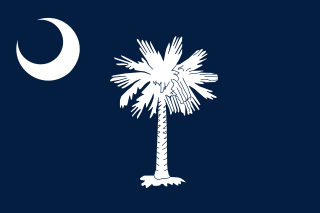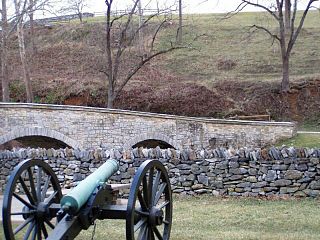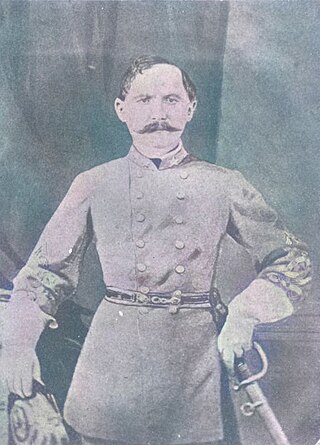The 201st Field Artillery Regiment is a West Virginia Army National Guard regiment. It currently perpetuates the Virginia elements of the Maryland and Virginia Rifle Regiment, which fought in the American Revolution. Organized by Colonel Morgan Morgan in Bunker Hill, West Virginia in 1735, it is one of the oldest continually-active regiments in the U.S. Army, and the oldest unit in the West Virginia Army National Guard. Units also saw action on both sides of the American Civil War, with many companies of the regiment combined to form the Union Army's 1st West Virginia Infantry.

Hampton's Legion was an American Civil War military unit of the Confederate States of America, organized and partially financed by wealthy South Carolina planter Wade Hampton III. Initially composed of infantry, cavalry, and artillery battalions, elements of Hampton's Legion participated in virtually every major campaign in the Eastern Theater, from the first to the last battle.
The Pointe Coupee Artillery was a Confederate Louisiana artillery unit in the American Civil War made up primarily of men from the parishes of Pointe Coupee, East Baton Rouge, Livingston and other surrounding parishes as well as a large number of men from New Orleans.
The 141st Infantry Regiment is an infantry regiment in the United States Army. The lineage of the 141st includes units tracing origins to the Texas Revolution, such as Company A, First Texas, 1836, and other infantry companies of the First Texas formed in the 1870s and 1880s.
The 3d Arkansas Cavalry Regiment (1861–1865) was a Confederate Army Cavalry regiment during the American Civil War.

Thomas' Legion, also known as Thomas' Legion of Cherokee Indians and Highlanders, Thomas' Legion of Indians and Highlanders, and the 69th North Carolina Regiment, was a unit of the Confederate Army in the American Civil War. The formation was organized in 1862 by William Holland Thomas and fought in the last skirmish of the war in North Carolina before surrendering in May 1865.
The 14th (McCarver's) Arkansas Infantry (1861–1865) was a Confederate Army infantry regiment during the American Civil War. Almost as soon as the regiment was formed, it was divided into two separate units. The first five companies were organized into the 9th Arkansas Infantry Battalion, while the remainder of the companies would become the 18th Arkansas Infantry Battalion. The 9th Arkansas Infantry Battalion was later merged with the 8th Arkansas Infantry and served for the rest of the war as part of that regiment, While the 18th Arkansas Infantry Battalion was consolidated with the remnants of the 17th Arkansas Infantry Regiment (Lemoyne's); the combined unit was then designated the 21st Arkansas Infantry Regiment (Craven's). A tenth company was added in December, 1862. The companies were from Izard, Lawrence, and Randolph counties.

The 6th Regiment New York Heavy Artillery, U.S. Volunteers, the "Anthony Wayne Guard", was an artillery regiment of the Union Army during the American Civil War. It was originally mustered in as the 135th New York Volunteer Infantry Regiment, and served as both artillery and infantry.

The 32nd Texas Cavalry Regiment, sometimes incorrectly named Andrews's 15th Texas Cavalry Regiment, was a unit of volunteer cavalry mustered into the Confederate States Army in May 1862 and which fought during the American Civil War. The regiment was formed around companies from Richard Phillip Crump's 1st Texas Cavalry Battalion which fought in Indian Territory and at Pea Ridge. Many of the soldiers died of disease in the unhealthy camps near Corinth, Mississippi. The cavalrymen were dismounted in July 1862 and served as infantry for the rest of the war. The regiment fought at Richmond, Ky., Stones River, and Chickamauga in 1862–1863, in the Meridian and Atlanta campaigns and at Nashville in 1864, and at Spanish Fort and Fort Blakeley in 1865. The regiment's 58 surviving members surrendered to Federal forces on 9 May 1865.

The 8th Massachusetts Battery was an artillery battery that served in the Union Army during the American Civil War. The units personnel enlisted for six months in 1862, but during its brief service it participated in the battles of Second Bull Run, Chantilly, South Mountain, and Antietam. The battery was mustered out on 29 November 1862, having lost one enlisted man killed in action and 10 men dead of disease.

The 623rd Field Artillery Regiment (Morgan's Men) is a single-battalion unit of the Kentucky Army National Guard. The unit draws its lineage from cavalry and infantry units of the Kentucky Militia formed in 1846 for service in the Mexican–American War. Its antecedents include units that served on both sides of the American Civil War as well as those that fought for the United States in the Spanish–American War, World War One and World War Two. The unit was first designated as the 623rd Field Artillery Battalion in 1947, serving under that name in the Korean War. It was part of the 138th Artillery Regiment in the 1960s before becoming the 623rd Artillery Regiment in 1969 and the 623rd Field Artillery Regiment in 1972. The unit served in the Gulf War as a self-propelled artillery unit; it is now equipped with the M142 HIMARS system.

The 1st Texas Cavalry Regiment was a unit of mounted volunteers from Texas that fought in the Confederate States Army during the American Civil War. It was first organized as a 10-company regiment by Colonel Henry Eustace McCulloch in April 1861 and named the 1st Texas Mounted Rifles. In early May 1861, the regiment secured the surrender of the small Federal garrison of San Antonio. Except from a skirmish with Native Americans in November 1861, the regiment took part in no more actions. In April 1862, the unit was reduced to five companies and renamed the 8th Texas Cavalry Battalion. On 2 May 1862, William Overall Yager's 3rd Texas Cavalry Battalion was consolidated with the 8th Cavalry Battalion to form a new 1st Texas Cavalry Regiment under Colonel Augustus Buchel, a German soldier of fortune who emigrated to Texas in 1845. The regiment served on the Texas Gulf Coast in 1863 but later transferred to Louisiana. In 1864, it fought at Mansfield, Pleasant Hill, and Yellow Bayou in the Red River Campaign. After Buchel was killed at Pleasant Hill, Yager led the regiment for the rest of the war. The unit was included in the 2 June 1865 surrender.

The 34th Texas Cavalry Regiment was a unit of mounted volunteers from Texas that fought in the Confederate States Army during the American Civil War. Almerine M. Alexander organized the regiment from north Texas recruits in the winter of 1861–1862. The unit marched to Indian Territory in May 1862 where it joined a brigade commanded by Douglas H. Cooper. The regiment fought at Newtonia and McGuire's Store in fall 1862 afterward was dismounted. The regiment served as infantry at Prairie Grove in December 1862. It received orders to transfer to Louisiana in April 1863. The regiment joined a brigade led by Camille de Polignac in July 1863. The following year, the unit fought at Mansfield, Pleasant Hill, and Yellow Bayou during the Red River Campaign. In March 1865 the regiment was assigned to the Texas Infantry Division. Soon after, it marched to Texas where it disbanded in May 1865.
The 13th Texas Infantry Regiment was a unit of volunteers recruited in Texas that fought in the Confederate States Army during the American Civil War. The regiment organized between September 1861 and January 1862, and was originally called the 4th Texas Volunteer Regiment. It spent its entire existence patrolling the Texas Gulf Coast between Matagorda and Galveston. The unit was actually made up of infantry, cavalry, and artillery units, but was not designated a legion. In April 1862, four infantry companies transferred to the 15th Texas Infantry Regiment, while three cavalry and one artillery company transferred to Reuben R. Brown's 12th Texas Cavalry Battalion. In fall 1863, three additional infantry companies of the 13th Texas Infantry were added when the 12th Cavalry Battalion consolidated with Lee C. Rountree's Cavalry Battalion to form the 35th (Brown's) Texas Cavalry Regiment. The regiment's soldiers suffered from poor morale due to the lack of military action, disease, monotony, and lack of food. The troops were only involved in a few skirmishes with the United States Navy. The formal surrender date was in June 1865, but by that time most of the soldiers had returned home.
The 3rd Texas Infantry Regiment was a unit of volunteers recruited in Texas that fought in the Confederate States Army during the American Civil War. Surgeon Philip N. Luckett organized the regiment in summer 1861. The soldiers were recruited in central Texas and included significant numbers of German immigrants and Tejanos. Texans regarded Germans with suspicion, since many opposed slavery, while Tejanos were considered lazy and untrustworthy. Morale in the regiment was poor and the number of desertions was high. The unit garrisoned San Antonio in 1861 and 1862, before moving to Brownsville, Texas, in January 1863. The regiment traveled to Galveston in May 1863. The unit transferred to Arkansas in March 1864 where it joined William R. Scurry's 3rd Brigade in Walker's Texas Division. It fought at Jenkins' Ferry at the end of April 1864. The regiment marched to Hempstead, Texas, where it disbanded before the official surrender date of 26 May 1865.
The 21st Texas Infantry Regiment was a unit of volunteers recruited in Texas that fought in the Confederate States Army during the American Civil War. The regiment was formed in spring 1864 by consolidating William Henry Griffin's 21st Texas Infantry Battalion and Ashley W. Spaight's 11th Texas Cavalry Battalion. Spaight became colonel and Griffin became lieutenant colonel. Spaight's 11th Battalion existed as early as September 1862 with a strength of 400 men. In the 21st Regiment's only notable action, it ambushed and captured two Union gunboats in the Battle of Calcasieu Pass on 24 April 1864. The unit's duties were mainly guarding the Texas Gulf Coast. It moved to Marshall, Texas, in the winter of 1864–1865, then marched to Shreveport, Louisiana. In April 1865, the regiment returned to Texas before disbanding in May.








